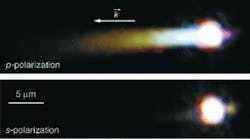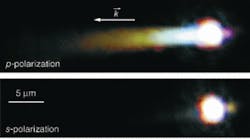Surface plasmons visualized as rainbow jets
Surface plasmons propagate along the interface between a conductor and a nonconductor or dielectric; they are bound to the interface and exponentially decay in both media. Commercial surface-plasmon (SP)-based sensors used in biological research and industrial environments are available, and research into new types of photonic devices using SPs is under way. The confinement at the interface and long propagation lengths of SPs make them candidates for integration in metallic and thin-film planar circuit designs. A direct measurement and visualization of SPs has been achieved by researchers at the Chemistry Division and Center for Nanoscale Materials at Argonne National Laboratory (Argonne, IL) to facilitate study of the propagation length of surface plasmons and their damping mechanisms.
To observe the SP radiation, the researchers used a variation of an existing technique in which an asymmetric structure formed by a thin metal film surrounded by two nonconducting media supports a surface-plasmon mode. As a nonradiative mode travels along an interface, the wave amplitude decays exponentially in the metal and is coupled into radiative light by the opposite interface that can be visualized. Surface plasmons are generally optically excited in an attenuated total-internal-reflection configuration with a large excitation area. With this configuration and for smooth metal films, the leakage radiation interferes destructively with the incoming excitation light at the reflection spot and cannot be detected. If the excitation area is smaller than the mean plasmon-propagation length, however, the leakage radiation can be observed classically. This method gives a direct measurement of the nonradiative SP traveling at the opposite interface that was previously accessible only through near-field probing techniques.
The researchers were able to excite an energetically broad SP continuum spanning the visible spectrum. They visualized the SP propagation by recording the real-space distribution of leakage radiation emitted by the surface-plasmon continuum as it traveled along an asymmetric air-silver-glass structure. The images revealed a spatial variation of the spectral components of the SP forming a rainbow-like jet (see figure).
Far-field technique
Leakage radiation emitted in the glass substrate by SPs traveling at the air-silver interface has a well-defined emission angle for every wavelength that is greater than the critical angle in the glass. To avoid total internal reflection of the leakage radiaton within the substrate, the researchers used an index-matched oil-immersion objective in contact with the substrate. This objective was part of a conventional inverted optical microscope focused on the silver-glass interface, with the leakage radiation being recorded by a CCD camera placed in the image plane.
The output of a regeneratively amplified Ti:sapphire laser system was used to create a white-light continuum in a nonlinear medium; the white light was focused by the objective lens onto the oil-glass-silver interface, produced by thermally evaporating 40- to 50-nm-thick silver films on cleaned glass coverslips. The continuum beam was polarized by a multiwavelength plate and a Glan-Thomson polarizer and injected into the optical path as a small beam of collimated white-light radiation within the back aperture of the lens.
The image that appears on the CCD consists of a bright-white illumination spot reflected at the glass-metal interface, followed by a rainbow jet that extends along the direction of the excitation-wave vector projected on the surface of the film. This is observed as a dispersion of the propagation length of the various spectral components composing the SP continuum. The blue part of the spectrum is confined closest to the excitation spot, while the red wavelengths propagate further on the film surface. When an s-polarized excitation beam is used, the rainbow jet is not observed because the SPs are p-polarized.
“Our approach for exciting and visualizing the plasmons is an entirely far-field approach and does not require scanning-probe methods; this is simply a unique means to actually see with your own eyes the plasmon as it propagates,” says Alexandre Bouhelier, distinguished postdoctoral fellow of the Center for Nanoscale Materials at Argonne National Laboratory. “We want to use broadband continuum generation of plasmons for new directions in optical sensing and devices for nanophotonics and also plan to explore the ultrafast aspect of the SP continuum for new forms of spectroscopy and nonlinear processes.”
REFERENCE
1. A. Bouhelier and G. P. Wiederrecht, Optics Lett. 30(8) 884 (April 15, 2005).

